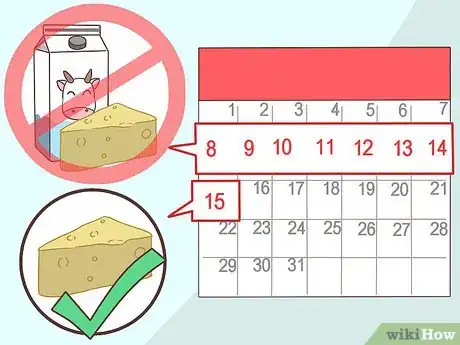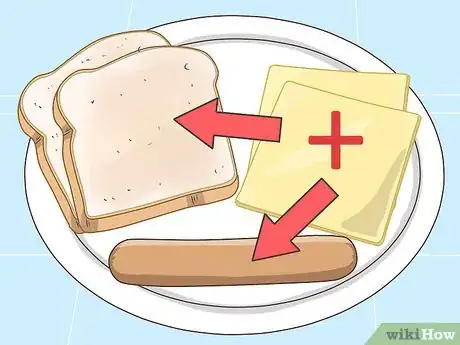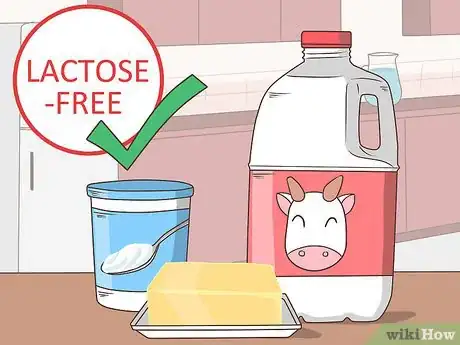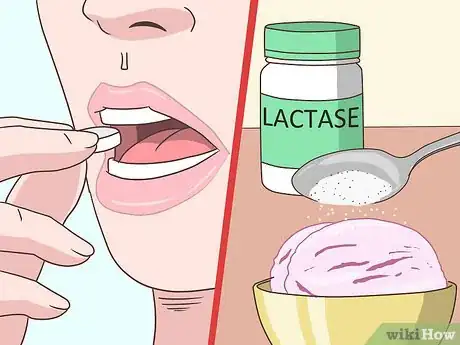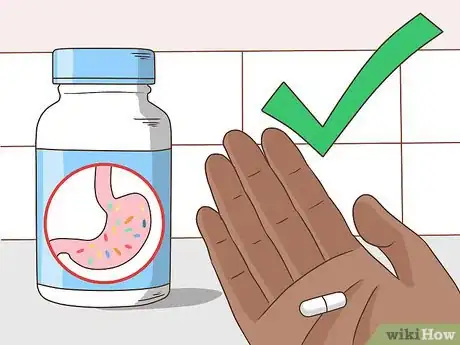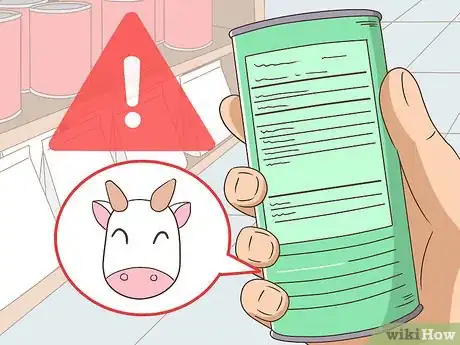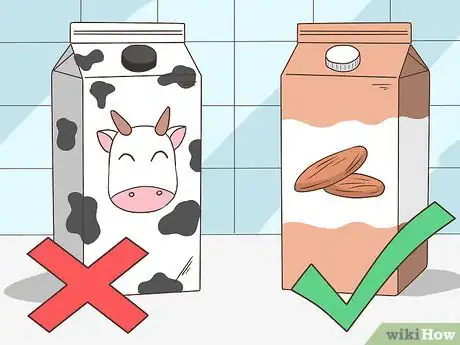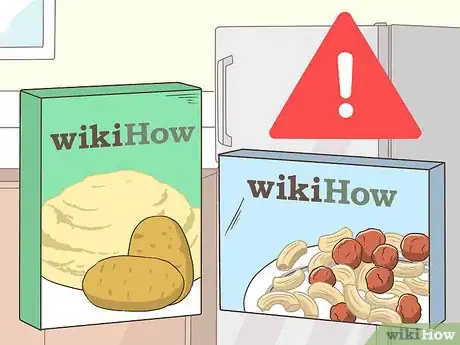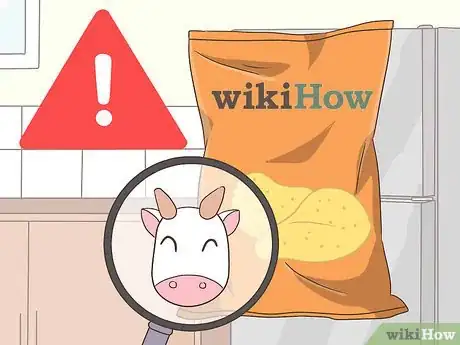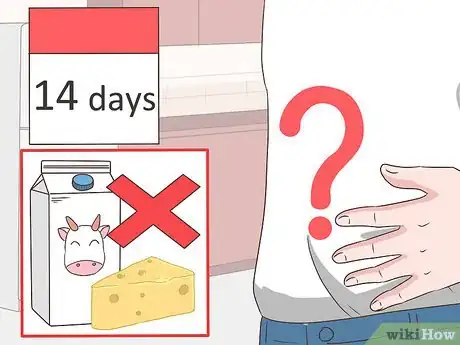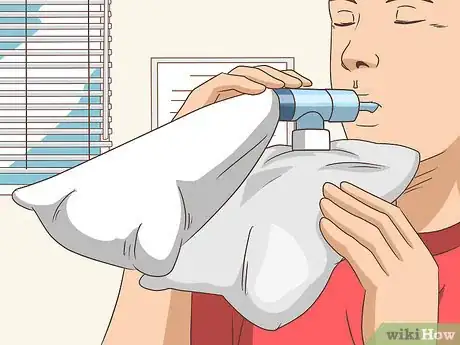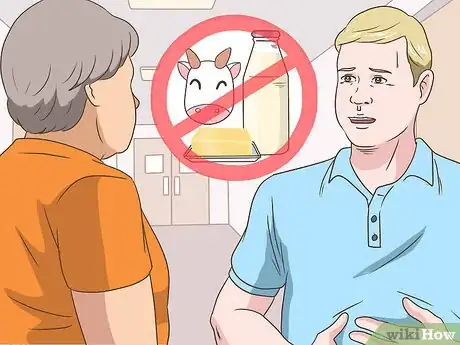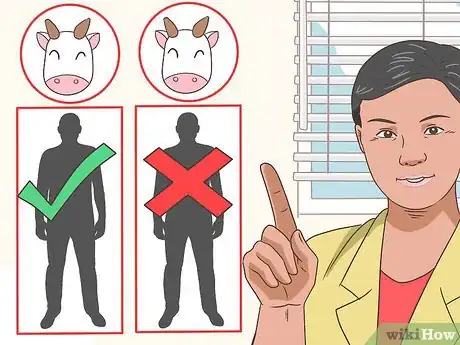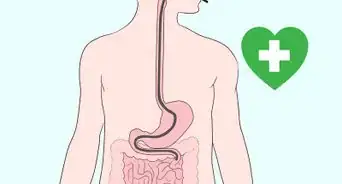This article was medically reviewed by Amy Chow. Amy Chow is a Registered Dietitian and the Founder of Chow Down Nutrition, a family and child nutrition consulting service in British Columbia (BC), Canada. With over nine years of experience, Amy has a special interest in pediatric nutrition, food allergy management, and eating disorder recovery. Amy holds a Bachelor’s degree in Nutritional Sciences from McGill University. She gained her clinical experiences at residential and outpatient eating disorder treatment programs as well as for BC Children’s Hospital before starting her own business. She has been featured on Find BC Dietitians, Dietitians of Canada, Food Allergy Canada, Recovery Care Collective, Parentology, Save on Foods, National Eating Disorder Information Centre (NEDIC), and Joytv.
There are 13 references cited in this article, which can be found at the bottom of the page.
wikiHow marks an article as reader-approved once it receives enough positive feedback. In this case, several readers have written to tell us that this article was helpful to them, earning it our reader-approved status.
This article has been viewed 117,782 times.
If you are lactose intolerant, drinking milk or eating dairy products might cause diarrhea, gas, or bloating – uncomfortable but generally harmless symptoms. This is because your body does not digest the sugar in dairy (lactose) properly.[1] You can probably manage your condition without having to give up all dairy, which is ideal because dairy products are great sources of calcium and vitamin D. Once you’ve confirmed you are lactose intolerant, manage the condition by knowing what foods to limit and how to approach dairy to minimize your symptoms.
Steps
Minimizing Symptoms When Eating Dairy
-
1Test your tolerance to specific products. Start by going dairy-free for several days. Then choose a day to attempt consuming one specific dairy product (for instance, eat cheese that day but no other dairy). Keep track of your symptoms. This way you can determine if there are certain products that do not upset your stomach. Very few people have such severe intolerance that they cannot eat dairy at all.
- Swiss, cheddar, and other hard cheeses have lower lactose and might cause fewer symptoms than soft cheese like ricotta and brie.
- Some people who are lactose intolerant can eat yogurt without a problem because of the bacteria cultures in it.[2]
- Low-fat and fat-free ice cream, hard cheese, cottage cheese, and yogurt contain less lactose per serving than milk. Some people who cannot drink milk can tolerate these other products in moderation.[3]
-
2Stick to small servings of dairy. Do not overwhelm your body with lactose. Try to limit drinking milk to 4 ounces at a time (118 ml) or less. Drink low-fat or fat-free milk instead of whole milk.[4]
- It’s likely that you can have some amount of dairy, and just have to discover your limit. Start with a very small serving of one dairy product, and if you do not have any symptoms, then try a larger serving the next day. With trial and error, you can determine what you can eat, and how much of it, without symptoms.[5]
Advertisement -
3Increase dairy consumption gradually. There’s no “cure” for lactose intolerance, but you may be able to make symptoms tolerable or even non-existent. Eliminate dairy products from your diet, and then begin to introduce them slowly. You may be able to help your body acclimate to increasing levels of dairy.
-
4Consume dairy with meals. You’re less likely to get symptoms if you have dairy with other food. Taking dairy with meals makes it easier for your body to digest everything, and will likely cause fewer symptoms for you than just having dairy on its own.[6]
-
5Get products that are lactose-reduced. Because lactose intolerance is so prevalent, many grocery stores carry lactose-reduced or lactose-free products. These generally do not taste any different than regular dairy products.[7] Lactose-free products shouldn’t cause you any stomach upset; whether or not you get symptoms from lactose-reduced products depends on your body and how much lactose is still in the product.
- Lactaid is a brand that sells many different types of lactose-free dairy products, such as milk, ice cream, cottage cheese, and eggnog.
-
6Include the lactose enzyme in your meal. Lactase is the enzyme that breaks down lactose in your body (most people are lactose intolerant because their body doesn’t have enough lactase). You can get tablets or drops from your drug store, usually over-the-counter, which contain lactase. These products come in different forms. Some you take as a tablet before eating lactose; others are liquids or powders that you add to dairy products.
- SureLac and Lactaid are some examples, but there are more.[8] Some brands of milk even contain the lactase enzyme to minimize the lactose in milk; look for this on the label.
- Using these products can be helpful if you’re unsure of the lactose content of a meal, like if you’re eating at a restaurant.[9]
- These products don’t help everyone who is lactose intolerant. Some people are lactose intolerant for a different reason than lactase deficiency.[10]
-
7Try taking probiotics. In their natural state, probiotics are tiny organisms that live in your gut and help you digest food and keep your intestines healthy. You can also get probiotics in capsule form from your pharmacy (usually over-the-counter). Taking probiotics may help ease diarrhea and symptoms of lactose intolerance, and can be tried if other treatments don’t work.[11]
- Probiotics are considered generally safe, but you should still check with your doctor before taking them to make sure they won’t interfere with any other health conditions or medications you take.
Recognizing Dairy Products
-
1Read product labels. Items that you might not expect to contain milk might actually have dairy, lactose, whey or other ingredients that can cause symptoms for the lactose intolerant. Be sure to read the Ingredients list on food items so you know what you’re consuming.
- Avoid or limit anything that directly states “lactose” in the ingredients. Be sure to check products like margarine, salad dressing, non-dairy creamer, baked products and pastries, and shortening.[12]
-
2Replace milk with non-dairy options. There are many products on the market that you can use to substitute for milk. Soy milk, rice milk, and almond milk are the most common, and often come in plain and flavored varieties.[13] You can also use coconut milk.[14] You can usually also use non-dairy creamer (though be sure to check the label for lactose).
- Stay away from other milk products like cream, buttermilk, malted milk, evaporated and condensed milk, and Kefir cultured milk.[15]
- To avoid all lactose, also exclude the following from your diet: cheese (including ricotta), cottage cheese, ice cream, whipped cream, sherbert, butter, cream cheese, hot cocoa mix, sour cream, yogurt, pudding, custard, and whey.[16]
-
3Know what goes into your starches. Breads and starches on their own don’t always contain lactose if they’re made fresh and without additives. However, avoid pre-made products like instant mashed potato mixes and frozen pre-made meals – or at least carefully read the ingredients.[17]
- Baked goods (cookies, cakes, pies, etc.) and breads may or may not be made with milk, so use caution.
-
4Watch out for hidden dairy ingredients. Milk, cheese, and other products that contain lactose can sometimes show up in meals and snacks that you wouldn’t expect. Be on the lookout for items that might contain hidden lactose:[18]
- Dips, for instance spinach and artichoke dip. These often contain cheese. Opt for salsa or hummus instead.
- Creamed vegetables (creamed peas, creamed corn) and cream-based soups (white chowders, for instance).
- Smoothies that contain yogurt
- Vegetables and meats that are coated in batter, i.e. fried.
- Cheese in things like pizza, burritos, casseroles, and in salads
- Confections such as toffee, caramel, and butterscotch
- Processed snacks like potato chips
-
5Ask your doctor about the medications you take. Even some medications contain lactose. The birth control pill might, as well as over-the-counter medicines to treat gas and acid reflux. If you have severe lactose intolerance and are taking these medications, talk to your doctor about possibly switching to another option.[19]
Diagnosing and Discussing Your Condition
-
1Keep a food diary. Create a record of your dairy consumption and symptoms from day to day. Keep track of what dairy foods you eat (milk, yogurt, ice cream, cheese, cottage cheese), the serving size, what time you eat them, and what you eat with them. In another column, keep track of when you have symptoms, what the symptoms are, and how long they last. This can help you and your doctor make a diagnosis, and figure out which foods are most likely to give you symptoms.[20]
- Use a notebook, journal, online tool like excel or Google Docs, or wall chart – whatever helps you stay organized. If you want to keep your symptoms private, use something hand-held that only you can access.
-
2Experiment with dairy deprivation. If you think you may be lactose intolerant, try to avoid eating dairy for a couple days or even 1-2 weeks. Make note of whether or not your symptoms subside or go away. Inform your doctor if your symptoms improve when you don’t have dairy.[21]
-
3See your doctor to get tested. Bloating, cramps, gas, diarrhea, or stomach noise shortly after eating might be caused by lactose intolerance.[22] [23] However, you want to be sure you know what is causing your symptoms, and rule out any other possible reasons for your stomach upset. Make a doctor’s appointment to get tested, and discuss the possible cause of your lactose intolerance. There are a few different kinds of tests that your doctor can do:[24]
- For a lactose tolerance test, you drink a liquid containing lots of lactose and have a blood test done two hours later.[25]
- For the hydrogen breath test you also drink a high-lactose liquid, and then your doctor measures how much hydrogen is in your breath at set intervals.[26]
- A stool acidity test simply checks a stool sample; it is used for infants or children who can’t do the other tests.
-
4Explain lactose intolerance to others. It might feel stressful if you have to change your diet, and you might be worried about what others will think. Fortunately, many people eat specific diets and you can explain your condition to others however you want to. Be vague, offer a simple explanation, or – if you want – wow others with your scientific knowledge!
- It’s okay to say simply, “Dairy upsets my stomach so I try to stay away from it,” or, “If I have too much milk, I feel sick.”
- You can also be specific, if you want to educate others. Say something like, “I’m lactose intolerant because I don’t have enough of the enzyme in my body that breaks down the sugar in milk, lactose.”
-
5Address myths and misunderstandings. Some people might think that if you drink a sip of milk or can eat yogurt, you’re lying about being lactose intolerant. Many people simply don’t understand the condition. Explain that most people who are lactose intolerant can eat some dairy products and not others, or dairy in small amounts.
- You can try to explain to people using an example, such as, “It probably wouldn’t affect you very much if you drink half a cup of coffee, but if you drink four espressos you might feel jittery, right? That’s how I am with dairy – a little is okay, a lot makes me feel sick.”
- You can also explain that you’re not allergic to milk, so drinking it isn't unsafe. Explain that it’s the sugar in dairy that upsets your stomach, and there’s more milk sugar in some things (like whole milk) than others (like dairy and hard cheeses).
Expert Q&A
-
QuestionWhat substitutes can I use in place of milk?
 Katie Marks-Cogan, MDDr. Katie Marks-Cogan is a board certified Pediatric & Adult Allergist at Clear Allergy based in Los Angeles, California. She is the Chief Allergist for Ready, Set, Food!, an infant dietary supplement designed to reduce the risk of childhood food allergies. She received her M.D. with honors from the University of Maryland. She then completed her residency in Internal Medicine at Northwestern University and fellowship in Allergy/Immunology at the University of Pennsylvania and CHOP.
Katie Marks-Cogan, MDDr. Katie Marks-Cogan is a board certified Pediatric & Adult Allergist at Clear Allergy based in Los Angeles, California. She is the Chief Allergist for Ready, Set, Food!, an infant dietary supplement designed to reduce the risk of childhood food allergies. She received her M.D. with honors from the University of Maryland. She then completed her residency in Internal Medicine at Northwestern University and fellowship in Allergy/Immunology at the University of Pennsylvania and CHOP.
Board Certified Pediatric & Adult Allergist There are a lot of milk alternatives available, including coconut milk, soy milk, and rice milk. Soy milk is thin and doesn't have a lot of flavor, whereas coconut milk is a lot creamier.
There are a lot of milk alternatives available, including coconut milk, soy milk, and rice milk. Soy milk is thin and doesn't have a lot of flavor, whereas coconut milk is a lot creamier. -
QuestionMy son ate something at school that had lactose in it. Is there anything to treat the pain, gas, or diarrhea when this happens?
 Jennifer Boidy, RNJennifer Boidy is a Registered Nurse in Maryland. She received her Associate of Science in Nursing from Carroll Community College in 2012.
Jennifer Boidy, RNJennifer Boidy is a Registered Nurse in Maryland. She received her Associate of Science in Nursing from Carroll Community College in 2012.
Registered Nurse You should call your primary care doctor or pediatrician to discuss the symptoms, and they can recommend the best treatment options for your son.
You should call your primary care doctor or pediatrician to discuss the symptoms, and they can recommend the best treatment options for your son.
Warnings
- Ask a doctor before taking any medications.⧼thumbs_response⧽
- Watch out for and avoid “sweet whey powder” or “whey powder” in processed products.⧼thumbs_response⧽
- See your doctor if you have severe symptoms after eating dairy, especially if you are concerned you aren’t getting enough calcium.[29]⧼thumbs_response⧽
References
- ↑ http://www.mayoclinic.org/diseases-conditions/lactose-intolerance/basics/definition/con-20027906
- ↑ https://www.drugs.com/mcd/lactose-intolerance
- ↑ https://www.nichd.nih.gov/sites/default/files/publications/pubs/documents/NICHD_MM_Lactose_FS_rev.pdf
- ↑ https://www.nichd.nih.gov/sites/default/files/publications/pubs/documents/NICHD_MM_Lactose_FS_rev.pdf
- ↑ https://www.drugs.com/mcd/lactose-intolerance
- ↑ https://www.drugs.com/mcd/lactose-intolerance
- ↑ https://www.drugs.com/mcd/lactose-intolerance
- ↑ https://www.drugs.com/cdi/lactaid.html
- ↑ http://www.mayoclinic.org/healthy-lifestyle/nutrition-and-healthy-eating/expert-blog/are-you-experiencing-lactose-intolerance/bgp-20252070
- ↑ https://www.drugs.com/mcd/lactose-intolerance
- ↑ https://www.drugs.com/mcd/lactose-intolerance
- ↑ https://www.drugs.com/cg/lactose-free-diet.html
- ↑ https://www.drugs.com/cg/lactose-free-diet.html
- ↑ Katie Marks-Cogan, MD. Board Certified Pediatric & Adult Allergist. Expert Interview. 9 December 2019.
- ↑ https://www.drugs.com/cg/lactose-free-diet.html
- ↑ https://www.drugs.com/cg/lactose-free-diet.html
- ↑ https://www.drugs.com/cg/lactose-free-diet.html
- ↑ https://www.drugs.com/cg/lactose-free-diet.html
- ↑ https://www.webmd.com/digestive-disorders/treatment-lactose-intolerance#2
- ↑ Katie Marks-Cogan, MD. Board Certified Pediatric & Adult Allergist. Expert Interview. 9 December 2019.
- ↑ https://www.nhs.uk/conditions/food-intolerance/
- ↑ https://www.mayoclinic.org/diseases-conditions/lactose-intolerance/symptoms-causes/syc-20374232
- ↑ Amy Chow. Registered Dietitian. Expert Interview. 6 October 2022.
- ↑ http://www.mayoclinic.org/diseases-conditions/lactose-intolerance/basics/tests-diagnosis/con-20027906
- ↑ Amy Chow. Registered Dietitian. Expert Interview. 6 October 2022.
- ↑ Amy Chow. Registered Dietitian. Expert Interview. 6 October 2022.
- ↑ https://www.drugs.com/mcd/lactose-intolerance
- ↑ https://www.drugs.com/mcd/lactose-intolerance
- ↑ http://www.mayoclinic.org/diseases-conditions/lactose-intolerance/basics/causes/con-20027906
About This Article
If you're lactose intolerant, you might not need to give up dairy completely. Try eating small amounts of dairy to see how your body handles it. If you don't experience any uncomfortable symptoms, try gradually increasing how much dairy you eat per day, which can help your body get used to it. Eat your daily serving of dairy with other food, since your body will be able to digest it better that way. Even if small servings of dairy still give you bad symptoms, you can still eat dairy by shopping for lactose-reduced products at the grocery store or by adding lactase drops to your food. These drops contain the enzyme that breaks down lactose, and they help your body digest dairy better. For advice from our Medical co-author, like how to grocery shop when you're lactose intolerant, keep reading!
